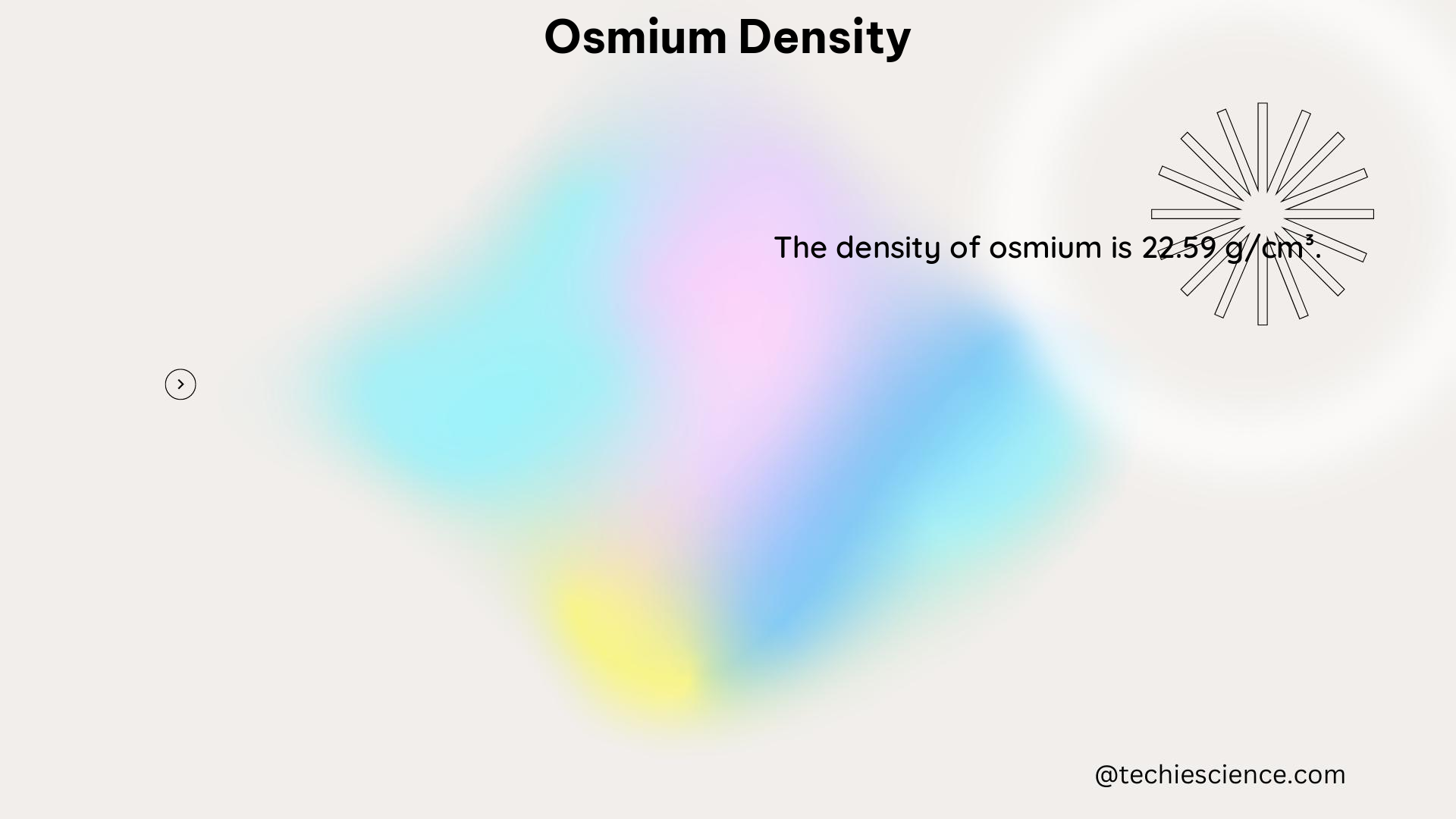Osmium is the densest known element on Earth, with a staggering density of 22.61 g/cm³. This means that a mere 1 cm³ sample of osmium would weigh a remarkable 22.61 grams. Understanding the unique properties and applications of this extraordinary element is crucial for physicists, chemists, and materials scientists alike.
The Density of Osmium: Unraveling the Mysteries
Osmium’s exceptional density is a result of its atomic structure and the arrangement of its electrons. As a member of the platinum group metals, osmium has a high atomic number (76) and a compact, close-packed crystal structure. This dense packing of atoms, combined with the element’s high atomic weight, contributes to its remarkable density.
Calculating Osmium Density
The density of a substance is defined as its mass per unit volume, expressed in the formula:
ρ = m / V
Where:
– ρ is the density of the substance
– m is the mass of the substance
– V is the volume of the substance
For osmium, the density can be calculated as follows:
ρ_osmium = 22.61 g/cm³
This means that a 1 cm³ sample of osmium would have a mass of 22.61 grams.
Comparing Osmium to Other Elements
To better understand the exceptional density of osmium, let’s compare it to other common elements:
| Element | Density (g/cm³) |
|---|---|
| Osmium | 22.61 |
| Iridium | 22.56 |
| Platinum | 21.45 |
| Gold | 19.30 |
| Lead | 11.34 |
| Iron | 7.87 |
| Aluminum | 2.70 |
As the table shows, osmium is the densest known element, surpassing even the density of iridium, the second-densest element. This extreme density has significant implications for the element’s applications and handling.
Calculating the Volume of Osmium Samples
To determine the volume of an osmium sample with a given mass, we can use the formula:
V = m / ρ
Where:
– V is the volume of the sample
– m is the mass of the sample
– ρ is the density of osmium (22.61 g/cm³)
For example, to find the volume of a 10.0 kg sample of osmium, we can calculate:
V = 10.0 kg / 22.61 g/cm³ = 441.5 cm³
This means that a 10.0 kg sample of osmium would occupy a volume of 441.5 cm³, or approximately 0.44 liters.
Unique Properties and Applications of Osmium

In addition to its extraordinary density, osmium possesses several other remarkable properties that make it a valuable and sought-after element.
Hardness and Wear Resistance
Osmium is an extremely hard and wear-resistant material, with a Mohs hardness of 7-8. This makes it an ideal choice for applications where durability and longevity are crucial, such as in the tips of fountain pen nibs, electrical contacts, and surgical instruments.
Catalytic Properties
Osmium is a highly effective catalyst, particularly in the oxidation of organic compounds. This property has led to its use in various chemical processes, including the production of pharmaceuticals and the synthesis of fine chemicals.
Corrosion Resistance
Osmium is highly resistant to corrosion, even in the presence of strong acids and bases. This makes it a valuable material for use in harsh environments, such as in the production of specialized laboratory equipment and in the aerospace industry.
Unique Crystal Structure
Osmium has a unique, close-packed hexagonal crystal structure that is distinct from other platinum group metals. This distinctive structure can be used for the identification and authentication of osmium samples, as well as in the development of specialized materials.
Rarity and Value
Osmium is an extremely rare element, with an abundance in the Earth’s crust of only about 1.5 parts per billion by weight. This scarcity, combined with its unique properties, makes osmium a highly valuable and sought-after material, particularly in the jewelry and investment markets.
Conclusion
Osmium’s exceptional density, hardness, and other unique properties make it a fascinating and valuable element in the world of physics and materials science. Understanding the intricacies of osmium’s density and its practical applications is crucial for researchers, engineers, and industry professionals working with this remarkable substance.
References
- Homework.study.com. (n.d.). Osmium – Density, Mass, and Volume. Retrieved from https://homework.study.com/explanation/osmium-rho-22-61-g-cm-3-is-the-most-dense-element-known-to-man-what-volume-of-osmium-is-needed-to-have-a-mass-of-10-0-kg-by-what-factor-is-this-smaller-than-the-volume-of-titanium-rho-4-506-g-cm-3-needed-for-the-same-mass-of-metal.html
- Chemicool.com. (n.d.). Osmium Element Facts. Retrieved from https://www.chemicool.com/elements/osmium.html
- Elevatedmagazines.com. (n.d.). Osmium – The Sunshine Element. Retrieved from https://www.elevatedmagazines.com/single-post/osmium-the-sunshine-element
- Homework.study.com. (n.d.). The Density of Osmium (The Densest Metal) is 22.57 g/cm3. What Would Be the Volume in mL of a 1.00 kg Sample of Osmium? Retrieved from https://homework.study.com/explanation/the-density-of-osmium-the-densest-metal-is-22-57-g-cm3-what-would-be-the-volume-in-ml-of-a-1-00-kg-sample-of-osmium.html

The lambdageeks.com Core SME Team is a group of experienced subject matter experts from diverse scientific and technical fields including Physics, Chemistry, Technology,Electronics & Electrical Engineering, Automotive, Mechanical Engineering. Our team collaborates to create high-quality, well-researched articles on a wide range of science and technology topics for the lambdageeks.com website.
All Our Senior SME are having more than 7 Years of experience in the respective fields . They are either Working Industry Professionals or assocaited With different Universities. Refer Our Authors Page to get to know About our Core SMEs.